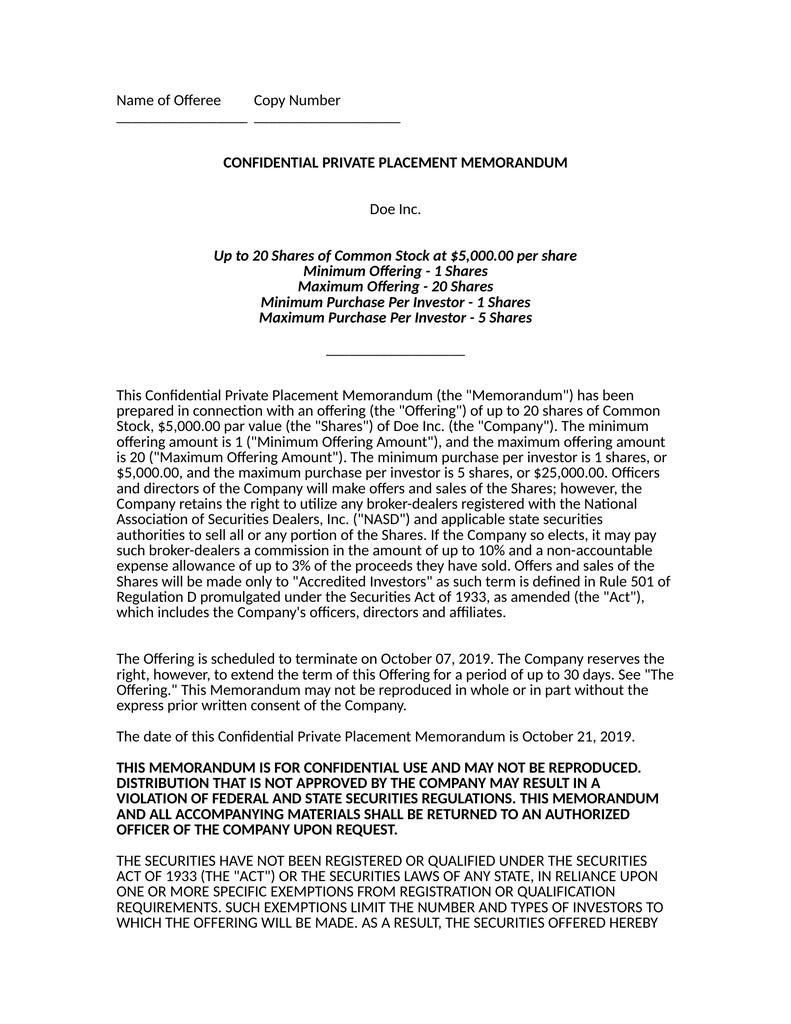Entrepreneurs decide that when it comes to raising money, they can (or must) use a private placement memorandum (PPM) to notify potential investors about the structure of their company, the investment opportunity, and the risks associated with both. As you weigh the importance and need of an offering memorandum in your particular case, you might be wondering, “What goes in a PPM? ” The information in this article will help you understand the purpose and give you a checklist for private placement memorandums. We’ll also look at an example of a private placement memorandum.
What Is Private Placement Memorandum?
A private placement memorandum (PPM) is a legal document sent to prospective investors when a company sells the stock. It is also known as an offering memorandum or offering the paper. A PPM is used in “private” transactions where there are no securities registrations under applicable federal or state law. Instead, they sell it under one of the exemptions from registration. The PPM describes the entity selling the securities, the terms of the sale, and the risks of the investment. The disclosures in the PPM differ. It depends on the exemption from registration used, the target buyers, and the length of the offering’s terms.
The PPM is significant because it provides the investor with all of the necessary data to make an investment decision. It also provides the actual paperwork to complete the investment transaction. PPMs aim is to be stand-alone documents. This means that one does not need to provide the investor with additional details to make a proper investment decision.
Private Placements are also known as Private Stock Offerings. They are “private” equity/debt deals that are far less costly to complete than an initial public offering, or IPO.
Types of Private Placement Memorandum
The various types of PPMs available includes the following;
- Promissory notes
- Sale of common stock in corporations
- Mutual fund in trust
- Bond offered for sale by county
General Guidelines for Creating Ppms
PPMs, or private placement memorandums, serve two functions. They aim to serve as both an enforcement and a marketing tool. You may notice that enforcement and marketing have very different objectives. Thus making PPMs exercise balance. The balance should favor enforcement (risk mitigation). However, you (and your lawyers) cannot overlook the value of creating a document that invites investors to invest! There are many ways to accomplish this while also protecting your business and yourself from unnecessary harm.
The remainder of this article assumes that your company qualifies for one of several exemptions that allow you to escape SEC registration for the securities you will issue. This is a topic for another post. For now, you should be aware that if you issue securities in the United States (or outside the United States but subject to U.S. laws), you must Either have an exemption from registration or register the securities with the SEC before issuing them. Furthermore, since certain exemptions require specific types of information disclosure, the specific exemption can drive certain PPM requirements.
Private Placement Memorandum Basic Requirements

You should write the PPMs in plain English (simple wording) to the greatest extent possible. So, PPMs are more concerned with the legal issues concerning the private securities being sold. This does not imply that they should be written in complex legalese. After all, PPMs are marketing resources for potential investors who are thinking about putting their money—and, to some degree, their faith—in the issuing firm.
In creating the right PPM for your startup, one thing to keep in mind is that there is no one-size-fits-all solution. In reality, the contents of a PPM can differ depending on the deal structure, market, and target audience. Also, it differs particular exemption that an issuer (the business selling securities) is relying on to escape SEC registration. As previously stated, this last item – the exemption you are using – will necessitate the inclusion of specific details in your PPM.
Read also: Development Finance: Easy Best Practices to scale any Business(+ Detailed Courses)
Checklist for Private Placement Memorandums
A private placement memorandum (PPM) is best produced with the assistance of a specialist. Although samples and models are available on the internet, the PPM must go far beyond the generic standard to resolve the terms and risks of your offering. Having said that, these are the checklist for the main parts of a PPM that should be used in almost every private placement memorandum.
#1. Cover Sheet and Table of Contents
Use a cover sheet with your company name, contact details, and date to open the folder. The table of contents should then outline all of the parts as well as any appendices or exhibits that you’ll attach.
#2. Key Disclosures
Use cautionary language before entering into the terms of the investment to clarify the purpose of the document and the limitations of its uses.
#3. Summary:
A few pages-long summaries should include an overview of the entire document, the company, and the securities offerings.
#4. Risk Factors
This segment should concentrate on the relevant and general risks that the company faces that will affect the valuation of its shares.
#5. Usage of Proceeds
Investors want to know how you’ll their money to propel the business forward. The funds should not be used for general operating expenses (except during a restricted startup period). This information on a private placement memorandum helps to build capacity or buy assets that will allow for significant development.
#6. Capitalization and Dilution
The capitalization portion, also known as the “cap table,” should clarify who owns what in the business right now. Dilution describes what happens to such shares when you sell more of them, including ownership and voting rights.
#7. Financial Data and Analysis
This is an opportunity to include a financial overview of the company’s history and future expectations. So, this information in a private placement memorandum shows the management’s analysis of the company’s financial condition.
#8. Business and Management
These pages, similar to a business plan, provide a more in-depth look at the company and its management team.
#9. Term Sheet:
The term sheet, also known as the offering description, describes the particular offer being offered, including the number of shares, the offering price, the fees that the company must pay on the capital raised, and the form of shares. There may be a minimum and a maximum number of shares that one must sell for the private placement memorandum to proceed. This knowledge is best presented in a table format.
Read Also: PRIVATE INVESTMENT: How To Start On The Right Foot With The Best Private investments Option
Private Placement Memorandum (Offering Memorandum) Example
Most private equity firms seek to increase their pace of growth without incurring debt or going public. If a manufacturing firm, for example, wishes to increase the number of plants it owns, it may use an offering memorandum (Private Placement Memorandum) to fund the expansion. When this occurs, the company must first determine how much money it needs to raise and at what price per share. In this case, the company needs $1 million to finance its expansion at $30 per share.
The business starts by drafting an offering memorandum (PPM) with the assistance of an investment bank or banker. This example of a private placement memorandum complies with the Securities and Exchange Commission’s securities rules (SEC). After compliance is achieved, the paper is distributed to a select group of interested parties, normally selected by the organization itself. In comparison, an initial public offering (IPO) allows everyone in the public to buy equity in the business.
The offering memorandum informs potential investors about the company, including the terms of the investment, the essence of the business, and the potential risk of the investment. A subscription agreement, which is a legal arrangement between the issuing company and the investor, is always in the document.
How is a PPM used in the due diligence process for investors?
A PPM is a critical component of the due diligence process for investors. It provides the investor with detailed information about the issuer and the offering, allowing the investor to make an informed decision about the investment. Investors should review the PPM carefully to understand the risks associated with the investment, including financial, operational, and regulatory risks. The PPM should also provide information about the expected return on investment, the terms of the offering, and the rights and obligations of the issuer and the investor.
What are the ongoing reporting requirements for issuers of securities offered under a PPM?
Issuers of securities offered under a PPM are typically required to provide ongoing financial and operational information to investors, including annual financial statements, management reports, and any other information deemed material to the investment. The frequency and nature of these reports will depend on the terms of the offering, as well as the specific laws and regulations applicable to the issuer. The goal of ongoing reporting is to provide investors with a clear picture of the issuer’s financial condition, operations, and prospects, allowing them to make informed decisions about the investment.
Can a PPM be amended after it has been distributed?
In some cases, a PPM may be amended after it has been distributed, for example, to reflect changes in the issuer’s business or financial condition, or to correct errors or omissions. However, the process of amending a PPM can be complex, and may require the consent of the investors, the issuer, and any relevant regulatory authorities. Amendments to a PPM should be carefully considered and made in accordance with applicable laws and regulations to ensure that the information provided to investors remains accurate and up-to-date.
What is the role of an underwriter in a PPM offering?
An underwriter may be involved in a PPM offering to assist the issuer in the sale of securities. The underwriter’s role may include underwriting the offering, meaning that the underwriter agrees to purchase the securities and sell them to investors. The underwriter may also provide the issuer with advice on the terms of the offering, assist in preparing the PPM, and assist in the marketing of the securities. The underwriter may also be responsible for ensuring that the offering complies with applicable laws and regulations.
What should be done if there are changes to the information contained in the PPM?
If there are changes to the information contained in the PPM, the issuer must promptly update the PPM to reflect the changes and distribute the updated PPM to investors. This is important to ensure that the information provided to investors is accurate and up-to-date, and to prevent the spread of false or misleading information about the investment. The process for updating a PPM will depend on the terms of the offering, as well as the specific laws and regulations applicable to the issuer.
What are the consequences of making false or misleading statements in a PPM?
Making false or misleading statements in a PPM can have serious legal and financial consequences for the issuer and any individuals involved in the preparation of the PPM. This includes the possibility of civil or criminal penalties, as well as damage to the issuer’s reputation and a reduction in the value of the securities. To avoid these consequences, it is important to carefully review the information contained in the PPM to ensure that it is accurate and complete, and to promptly update the PPM to reflect any changes.
Conclusion
Speak to a great lawyer before raising a private investment capital (whether from angel investors, venture capitalists, friends, and family, or other sources). This does not imply that you must always spend a lot of money or build a PPM (or, on the other hand, that just because a PPM is not a requirement for the particular securities exemption you use, you should automatically choose not to use a PPM to raise capital). It means, at the very least, that you consult with an experienced legal professional to determine the best decision for you, your cofounders, and your startup or more established business enterprise based on the particular circumstances surrounding how much money you are seeking, the investors you believe are likely to invest, and other important contextual evidence. Also, you can use the checklist to guide you while drafting a private placement memorandum.
Private placement memorandum FAQs
Is a PPM a contract?
So, a PPM can be thought of as a sort of hybrid between a business plan and a legal contract all in one
Do funds need a PPM?
PPM Required.
A PPM is not technically required for Rule 506(b) offers to only accredited investors and Rule 504 offers to either accredited or non-accredited investors. However, a PPM is usually advisable, even in those cases where it is not technically required. An issuer should view the PPM as a type of insurance
What should be included in a private placement memorandum?
A Checklist for the Main Topics (Information) in a Private Placement Memorandum
- Notices to Investors.
- Executive Summary.
- Company Purpose and Overview.
- Terms of the Offering and Securities.
- Risk Factors.
- Use of Proceeds.
- Financial Information.
- Management.
Is offering memorandum required?
FINRA Rule 5123 requires member firms to file the private placement memorandum, term sheet, or another offering document that sets forth the terms of the offering.
- PRIVATE INVESTMENT: How To Start On The Right Foot With The Best Private investments Option
- Accounting balance sheet explained: samples, templates, examples, and definition
- DEVELOPMENT BANKS: Beginners’ Guide with Examples (+Best picks)
- Development Finance: Easy Best Practices to scale any Business(+ Detailed Courses)






